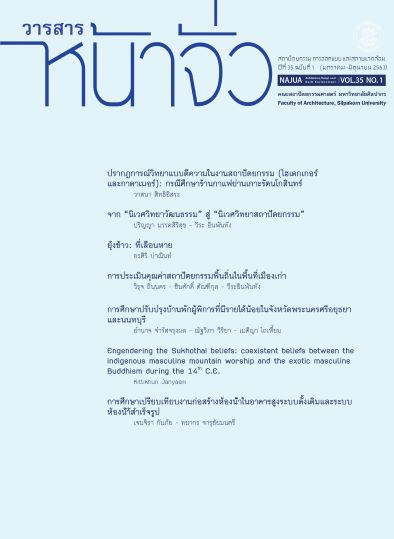Engendering the Sukhothai beliefs: coexistent beliefs between the indigenous masculine mountain worship and the exotic masculine Buddhism during the 14th C.E.
คำสำคัญ:
Sukhothai art, Buddhist art, Buddha’s footprint, mountain worship, gender of artบทคัดย่อ
This article evaluates the gender of Sukhothai art through the scrutiny of the literature of King Ram Khamhaeng and King Lidhaiya as well as the Buddhist art of Sukhothai during the mid-13th to 14th C.E.
Significantly, by integrating interdisciplinary theoretical frameworks and methods from art history in the traditional realms and the post-modern perspectives of gender, epigraphy, and landscape archaeology, this study discloses that the gender of art can be represented and seen in the coexistent beliefs between the indigenous Sukhothai masculine mountain worship and the exotic Singhalese masculine Buddhism, in which the significance of great masculinity had been embodied, in Sukhothai during the 14th C.E. Additionally, this study further evaluates that the power of the Buddhist art was exploited to support the righteousness of King Lidhaiya, and archaeologically evaluates that the indigenous sacred landscape of Khao Luang was the best sacred space for establishing the new exotic Buddha’s footprint (Buddhapāda) cult. Finally, the scrutiny of these two-distinctive beliefs allows us to see the continuous landscape use and the link of the different beliefs’ locus, in which the masculinity was embodied and made them exist contemporarily as a gendered representation through beliefs and art.
เอกสารอ้างอิง
- Brown, Robert. (1990). “God on Earth: The Walking Buddha in the Art of South and Southeast Asia”, Artibus Asiae, 50(1/2), 73-107.
- Dehejia, Vidya. (2009). The Body as Leitmotif. V. Dehejia. (Ed.). The Body Adorned: Dissolving Boundaries between the Sacred and the Profane in India’s Art. New York: Columbia University Press, 1-74.
- Griswold, Alexander and Na Nagara, Prasert. (1969). “The Pact Between Sukhodaya and Nan Epigraphic and Historical Studies, No.3”. Journal of Siam Society, 57(1), 57-107.
- Griswold, Alexander and Na Nagara, Prasert. (1971). “The Inscription of Vat Traban Jan Phoak (Face I, 1380 A.B.; Face II, 14th century, date uncertain): Epigraphic and Historical Studies No.7”. Journal of Siam Society, 59(1), 157-188.
- Griswold, Alexander and Na Nagara, Prasert. (1972). “Epigraphic and Historical Studies, No.10: King Lodaiya of Sukhodaya and his contemporaries”. Journal of Siam Society, 60(1), 21-153.
- Griswold, Alexander and Na Nagara, Prasert. (1973). “Epigraphic and Historical Studies No. 11, Part I: The Epigraphy of Mahadharmaraja I of Sukhodaya”. Journal of Siam Society, 61(1), 71-181.
- Krom Silapakon. (1983). Jaruek Samai Sukhothai. (In Thai). [Inscriptions of the Sukhothai Period]. Bangkok: The Fine Arts Department.
- Listopad, John. (2012). “The walking Buddha in Thailand. Heidi Tan and Alan Chong”. (Eds). Enlightened Ways: The Many Streams of Buddhist Art in Thailand. Singapore: Asian Civilisations Museum, 32-39.
- Monsterarchaeologist (2014). Banchee Borannawatthu Silpawatthu Nai Phi phitthaphanthasathan Haeng Phra Phutthabat Wat Phra Phutthabat Changwat Saraburi (In Thai). [An Artefact Inventory in Phra Phutthabat Museum, Wat Phra Phutthabat, Saraburi Province], Vol.2. Bangkok: Monsterarchaeologist.
- Norman, Kenneth Roy. (1983). Pali Literature, including the Canonical Literature in Prakrit and Sanskrit of all the Hinayana Schools of Buddhism. Wiesbaden: Harrassawitz.
- Paranavitana, Senarat. (1958). The God of Adam's Peak. Ascona, Switzerland: Artibus Asiae Publishers.
- Poolsuwan, Samerchai. (2016). Jittakam Phutthasatsana Samai Pagan: Roopbaeb Lae Khwammai Khong Silpa Haeng Sattha. (In Thai). [The Pagan-Period Buddhist Murals: Forms and Meanings of The Faith Art], Vol.1. Bangkok: Thammasat University Press.
- Powers, John. (2009). A Bull of a Man: Images of Masculinity, Sex and the Body in Indian Buddhism. Massachusetts: Harvard University Press.
- Preziosi, Donald. (2009). Coda. Donald Preziosi (Ed.). The Art of Art History. Oxford; New York: Oxford University Press, 504-509.
- Ray, Sugata. (2015). “The “Effeminate” Buddha, the Yogic Male Body and the Ecologies of Art History in Colonial India”. Art History. 38(5), 916-39.
- Stratton, Carol and Scott, Mariam McNair. (2004). Buddhist sculpture of Northern Thailand. Chiang Mai: Silkworm Books.
- Tennent, James Emerson, Sir. (1860). Ceylon: An account of the island physical, historical, and topographical with notices of its natural history, antiquities and productions (5th ed.). London: Longman, Green, Longman and Roberts.
- Tran, Ky Phuong. (2008). “The My Son and Po Nagar Nha Trang Sanctuaries: On the Cosmological Dualist Cult of the Champa Kingdom in Central Vietnam as Seen from Art and Anthropology”. Asia Research Institute Working Paper No. 100 (February 11, 2008), 1-22. Available at pSSRN: https://ssrn.com/abstract=1299327 or http://dx.doi.org/10.2139/ssrn.1299327





